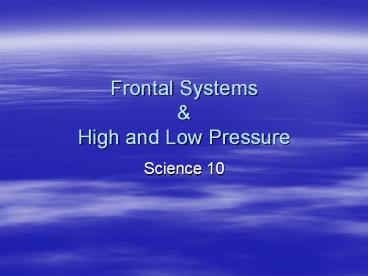Frontal Systems - PowerPoint PPT Presentation
1 / 18
Title:
Frontal Systems
Description:
Frontal Systems & High and Low Pressure Science 10 Frontal Systems Fronts are created when one air mass overtakes another They will typically be classified into two ... – PowerPoint PPT presentation
Number of Views:141
Avg rating:3.0/5.0
Title: Frontal Systems
1
Frontal SystemsHigh and Low Pressure
- Science 10
2
Frontal Systems
- Fronts are created when one air mass overtakes
another - They will typically be classified into two
categories - Warm front when warm air runs into cold air
- Cold front when cold air runs into warm air
3
Warm Front
4
Warm Front
- The warm air gradually climbs over the colder air
- Typical clouds associated with a warm front are
- Cirrus
- Cirrostratus
- Altostratus
- Nimbostratus
- Stratus
- Associated with periods of steady precipitation
- May exist over 50-100km
5
(No Transcript)
6
Cold Front
7
Cold Front
- Occurs when warm air is violently pushed up by
advancing cold air - Cumulus clouds are associated with a cold front
- Can result in cumulonimbus clouds
- Short periods of heavy precipitation
- Covers a small geographical area (2-5km)
8
(No Transcript)
9
Weather Map
10
High Pressure
- High pressure has more air above it
- It is pulled down by gravity
- Due to Coriolis Effect, it spins clockwise and
out in the Northern Hemisphere - Clear skies
- Light winds
11
Low Pressure
- Low pressure has less air above it
- Air from a high pressure flows towards a low
pressure - Due to Coriolis Effect, it spins counter
clockwise and in in the Northern Hemisphere - Clouds
- Strong winds
12
High and Low Pressures
13
Questions Pg. 32 9-12 Pg. 34
13-16
14
Pg. 32 9. Spherical Earth makes Suns
more or less concentrated.
- Air Mass- a very large mass of air that has
nearly uniform properties such as temperature,
humidity, and pressure. - -arctic (cold, dry)
- - continental polar (cool, dry)
- - continental tropical (hot, dry)
- - maritime polar (cool, humid)
- - maritime tropical (hot, humid)
15
11.
12. Coriolis Effect
16
Pg. 34
13. Jet streams are fast flowing, narrow air
currents found in the atmosphere, usually
between the Troposphere and the Stratosphere.
17
14. A Front is a zone that develops as a result
of the meeting of two air masses with different
characteristics.
- A Stationary Front- is when two air masses meet
but neither - advances.
18
16. When cold air replaces warm air we have a
Cold Front. Cold fronts usually bring short
periods of heavy precipitation.































